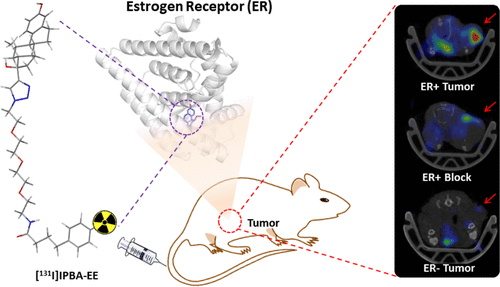当前位置:
X-MOL 学术
›
Anal. Chem.
›
论文详情
Our official English website, www.x-mol.net, welcomes your
feedback! (Note: you will need to create a separate account there.)
Radioiodinated 4-(p-Iodophenyl) Butanoic Acid-Modified Estradiol Derivative for ER Targeting SPECT Imaging
Analytical Chemistry ( IF 6.7 ) Pub Date : 2021-10-06 , DOI: 10.1021/acs.analchem.1c03616 Duo Xu 1, 2 , Xiaoru Lin 1 , Xinying Zeng 1 , Xuejun Wen 1 , Jingchao Li 1 , Yesen Li 3 , Jinxiong Huang 3 , Xiaoyuan Chen 4 , Zhide Guo 1 , Xianzhong Zhang 1
Analytical Chemistry ( IF 6.7 ) Pub Date : 2021-10-06 , DOI: 10.1021/acs.analchem.1c03616 Duo Xu 1, 2 , Xiaoru Lin 1 , Xinying Zeng 1 , Xuejun Wen 1 , Jingchao Li 1 , Yesen Li 3 , Jinxiong Huang 3 , Xiaoyuan Chen 4 , Zhide Guo 1 , Xianzhong Zhang 1
Affiliation

|
Overexpression of estrogen receptors (ERs) is one of the important characteristics of most breast cancers. We aim to develop a new type of ER-specific radioiodine-labeled estrogen derivative ([131I]IPBA-EE), which was modified with an albumin-specific ligand 4-(p-iodophenyl) butyric acid (IPBA) to improve the metabolic stability and enhance the ER-targeting ability of estrogen. [131I]IPBA-EE can effectively bind to albumin in vitro, and its dissociation constant (Kd = 0.31 μM) is similar to IPBA (Kd = 0.30 μM). The uptake of [131I]IPBA-EE in ER-positive MCF-7 cells (41.81 ± 3.41%) was significantly higher than that in ER-negative MDA-MB-231 cells (8.78 ± 2.37%, ***P < 0.0005) and could be significantly blocked (3.92 ± 0.35%, ***P < 0.0005). The uptakes of [131I]IPBA-EE in rat uterus and ovaries were 5.66 ± 0.34% ID/g and 5.71 ± 2.77% ID/g, respectively, at 1 h p.i., and these uptakes could be blocked by estradiol (uterus: 2.81 ± 0.41% ID/g, *P < 0.05; ovarian: 3.02 ± 0.08% ID/g, *P < 0.05). SPECT/CT imaging showed that ER-positive MCF-7 tumor uptake of [131I]IPBA-EE reached to 6.07 ± 0.20% ID/g at 7 h p.i., which was significantly higher than that of ER-negative MDA-MB-231 tumor (0.87 ± 0.08% ID/g, **P < 0.005) and could be blocked obviously with fulvestrant (1.65 ± 1.56% ID/g, *P < 0.05). In conclusion, a novel radioiodinated estradiol derivative, [131I]IPBA-EE with albumin-binding property and good metabolic stability, was developed to image the ER in breast cancer. This promising ER-targeted probe has the potential to warrant further preclinical investigations.
中文翻译:

用于 ER 靶向 SPECT 成像的放射性碘化 4-(对碘苯基)丁酸改性雌二醇衍生物
雌激素受体 (ER) 的过度表达是大多数乳腺癌的重要特征之一。我们的目标是开发一种新型 ER 特异性放射性碘标记的雌激素衍生物([ 131 I]IPBA-EE),该衍生物用白蛋白特异性配体 4-(对碘苯基)丁酸 (IPBA) 进行修饰,以改善代谢稳定性和增强雌激素的 ER 靶向能力。[ 131 I]IPBA-EE在体外可有效结合白蛋白,其解离常数(K d = 0.31 μM)与IPBA(K d = 0.30 μM)相似。[ 131]的摄取I] ER 阳性 MCF-7 细胞中的 IPBA-EE (41.81 ± 3.41%) 显着高于 ER 阴性 MDA-MB-231 细胞 (8.78 ± 2.37%, *** P < 0.0005) 并且可能是显着阻塞 (3.92 ± 0.35%, *** P < 0.0005)。[ 131 I]IPBA-EE 在大鼠子宫和卵巢中的吸收分别为 5.66 ± 0.34% ID/g 和 5.71 ± 2.77% ID/g,在感染后 1 小时,并且这些吸收可以被雌二醇(子宫: 2.81 ± 0.41% ID/g,* P < 0.05;卵巢:3.02 ± 0.08% ID/g,* P < 0.05)。SPECT/CT 成像显示,ER 阳性 MCF-7 肿瘤对 [ 131 I]IPBA-EE 的吸收在感染后 7 小时达到 6.07 ± 0.20% ID/g,显着高于 ER 阴性 MDA-MB- 231 个肿瘤(0.87 ± 0.08% ID/g,**P < 0.005)并且可以被氟维司群明显阻断(1.65 ± 1.56% ID/g,* P < 0.05)。总之,开发了一种具有白蛋白结合特性和良好代谢稳定性的新型放射性碘化雌二醇衍生物 [ 131 I]IPBA-EE,用于对乳腺癌中的 ER 进行成像。这种有前途的 ER 靶向探针有可能需要进一步的临床前研究。
更新日期:2021-10-19
中文翻译:

用于 ER 靶向 SPECT 成像的放射性碘化 4-(对碘苯基)丁酸改性雌二醇衍生物
雌激素受体 (ER) 的过度表达是大多数乳腺癌的重要特征之一。我们的目标是开发一种新型 ER 特异性放射性碘标记的雌激素衍生物([ 131 I]IPBA-EE),该衍生物用白蛋白特异性配体 4-(对碘苯基)丁酸 (IPBA) 进行修饰,以改善代谢稳定性和增强雌激素的 ER 靶向能力。[ 131 I]IPBA-EE在体外可有效结合白蛋白,其解离常数(K d = 0.31 μM)与IPBA(K d = 0.30 μM)相似。[ 131]的摄取I] ER 阳性 MCF-7 细胞中的 IPBA-EE (41.81 ± 3.41%) 显着高于 ER 阴性 MDA-MB-231 细胞 (8.78 ± 2.37%, *** P < 0.0005) 并且可能是显着阻塞 (3.92 ± 0.35%, *** P < 0.0005)。[ 131 I]IPBA-EE 在大鼠子宫和卵巢中的吸收分别为 5.66 ± 0.34% ID/g 和 5.71 ± 2.77% ID/g,在感染后 1 小时,并且这些吸收可以被雌二醇(子宫: 2.81 ± 0.41% ID/g,* P < 0.05;卵巢:3.02 ± 0.08% ID/g,* P < 0.05)。SPECT/CT 成像显示,ER 阳性 MCF-7 肿瘤对 [ 131 I]IPBA-EE 的吸收在感染后 7 小时达到 6.07 ± 0.20% ID/g,显着高于 ER 阴性 MDA-MB- 231 个肿瘤(0.87 ± 0.08% ID/g,**P < 0.005)并且可以被氟维司群明显阻断(1.65 ± 1.56% ID/g,* P < 0.05)。总之,开发了一种具有白蛋白结合特性和良好代谢稳定性的新型放射性碘化雌二醇衍生物 [ 131 I]IPBA-EE,用于对乳腺癌中的 ER 进行成像。这种有前途的 ER 靶向探针有可能需要进一步的临床前研究。

















































 京公网安备 11010802027423号
京公网安备 11010802027423号